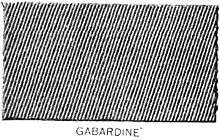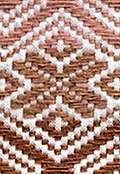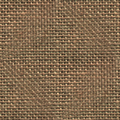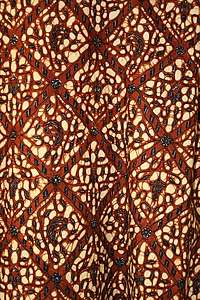Gabardine
Gabardine is a tough, tightly woven fabric used to make suits, overcoats, trousers, uniforms, windbreakers and other garments.


The word gaberdine or gabardine has been used to refer to a particular item of clothing, a sort of long cassock but often open at the front, since at least the 15th century, in the 16th becoming used for outer garments of the poor.
Etymology
The modern use of the term for a fabric rather than a garment dates to Thomas Burberry, who invented the fabric & revived the name in 1879, and patented it in 1888. It has been used with a general meaning of "closely woven cloth" since at least 1904.[1] Although its origin is unknown, the word may be related to the word kaba, a type of coat reaching to the knees with wide sleeves worn by Muslim men in Puraniya, a region of India.[2] There is another kind of coat, called a qabā, that is mentioned in Sufī scripture, which is an ordinary coat, as opposed to a religious coat.[3]
Fabric
The fibre used to make the fabric is traditionally worsted wool, but may also be cotton, texturised polyester, or a blend. Gabardine is woven as a warp-faced steep or regular twill, with a prominent diagonal rib on the face and smooth surface on the back. Gabardine always has many more warp than weft yarns.[4][5][6]
Cotton gabardine is often used by bespoke tailors to make pocket linings for business suits, where the pockets' contents would quickly wear holes in flimsy pocket lining material.
Clothing made from gabardine is generally labelled as being suitable for dry cleaning only, as is typical for wool textiles. Gabardine may also refer to the twill-weave used for gabardine fabric, or to a raincoat made of this fabric.
History
Gabardine was invented in 1879 by Thomas Burberry, founder of the Burberry fashion house in Basingstoke, Hampshire, England and patented in 1888. The original fabric was worsted wool or worsted wool in combination with cotton, and was waterproofed using lanolin[7] before weaving. It was tightly woven and water-repellent but more comfortable than rubberised fabrics.[5] The fabric takes its name from the word "gaberdine", originally a long, loose cloak or gown worn in the Middle Ages, but later signifying a rain cloak or protective smock-frock.[6][8]
Burberry clothing of gabardine was worn by polar explorers, including Roald Amundsen, the first man to reach the South Pole, in 1911 and Ernest Shackleton, who led a 1914 expedition to cross Antarctica. A jacket made of this material was worn by George Mallory on his ill-fated attempt on Mount Everest in 1924.[9]
Gabardine was also used widely in the 1950s to produce colourful patterned casual jackets, trousers and suits. Companies like J. C. Penney, Sport Chief, Campus, Four Star and California Trends were all producing short-waisted jackets, sometimes reversible, commonly known as weekender jackets.
Notes
- "Gabardine". Online Etymology Dictionary. Retrieved 2012-05-07.
- The History, Antiquities, Topography, and Statistics of Eastern India: By Robert Montgomery Martin.
- Kashf al-Mahjub.
- Kadolph (2007), pp. 240, 472
- Cumming (2010), p. 248.
- Picken (1957), p. 145
- [Royal Society of Chemistry]
- Cumming (2010), p. 88.
- "Replica clothes pass Everest test". BBC News.
References
- Cumming, Valerie, C. W. Cunnington and P. E. Cunnington. The Dictionary of Fashion History, Berg, 2010, ISBN 978-1-84788-533-3.
- Kadolph, Sara J., ed. Textiles, 10th edition, Pearson/Prentice-Hall, 2007, ISBN 0-13-118769-4.
- Picken, Mary Brooks. The Fashion Dictionary, Funk & Wagnalls, 1957. (1973 edition ISBN 0-308-10052-2.)



.svg.png)